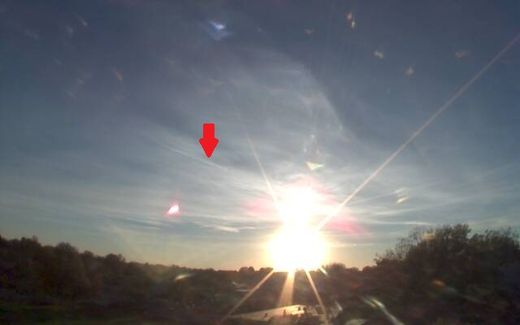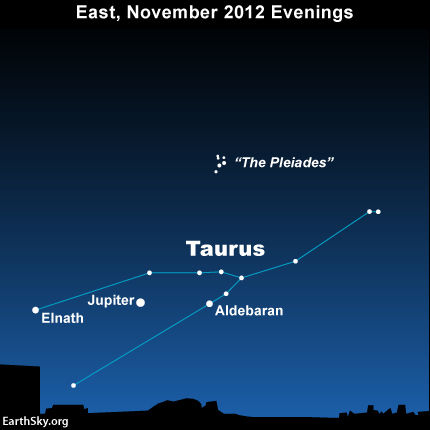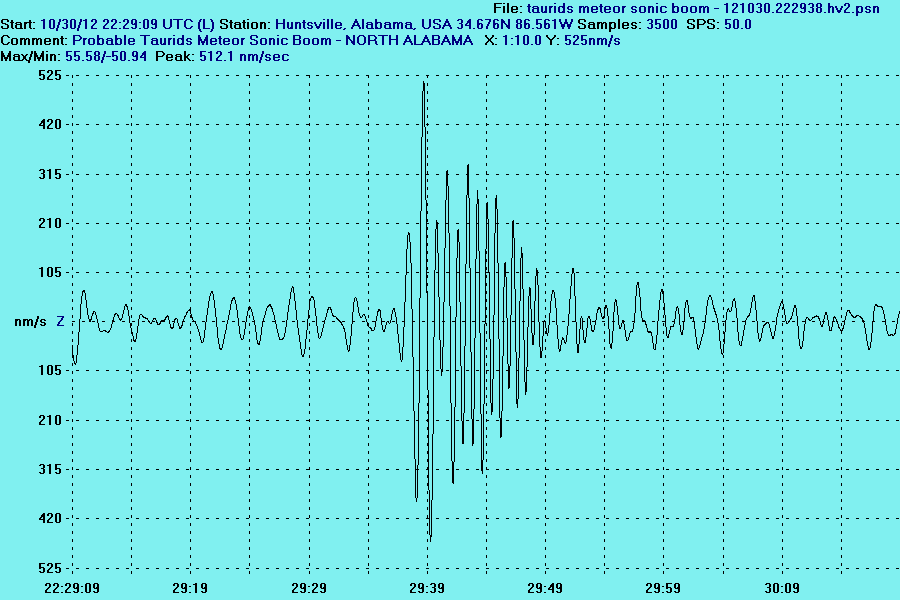
"This was NOT a Taurid meteor; probably a random interloper from the asteroid belt. Doppler weather radar shows a meteoritic "rain", indicating that there are meteorites on the ground in Alabama. The radar signature is stronger than the recent California fireball, which produced meteorites in the San Francisco area. We are still working out a precise location for the meteor impact."Though the meteor was not from the Taurid Meteor shower, there was one that was from the Taurid Meteor Shower that passed over parts of eastern and central Tennessee just after 6:00 am. Below is a statement from Dr. Bill Cooke and an image of the path of the fireball.
"So the bolide appeared some 44 miles above a point midway between the towns of Stanton and Mason, and moved slightly north of east at a speed 3 times faster than that of the International Space Station, finally terminating above the town of Pinson, which is southeast of Jackson, TN. Altitude at last visibility was 18.1 miles, which is fairly low for a meteor."Multiple reports on social media and phone calls have come into the station about a fireball in the sky late this afternoon and early this evening. Actually this is not the first report of a fireball in the sky today, there were reports of a fireball earlier today in Arkansas. Two meteor showers occur during the month of October, one which was the Orionid Meteor shower that peaked a couple weeks ago. The second is the Taurid Meteor Shower that started October 20th. NASA states that, "Taurids are slow, and you might see bright fireballs. The Orionids are fast and mostly faint." The Taurid Meteor Shower does not peak until November 10th and even then only seven meteors per hour are expected. So obviously it is more modest, but long lasting meteor shower. Likely the fireball seen in the sky early this evening was a meteor. The Taurid Meteor Shower is an annual meteor shower that radiates from the constellation Taurus the bull, hence it's name, as Earth passes through debri from the comet Encke.
According to National Geographic:
"Like most other meteor showers, the Taurids happen when Earth slams into a cloud of debris left behind by a passing comet.
But "this stream of cometary debris that produces the Taurids contains a large fraction of pebble-sized material in addition to the dust grain-size particles that make up most of the meteors we see enter Earth's atmosphere," said Michael Solontoi, an astronomer with the Alder Planetarium in Chicago.
When these larger bits of debris enter our atmosphere, they can produce spectacular fireballs.
Eyewitness reports describe fireball meteors as being brighter than any visible star or planet and even the full moon. Fireballs tend to trek across the sky at a noticeably slower pace and leave behind visible smoke trails that can last for minutes."
Comment: In short, the meteors you see during meteor showers are tiny pebbles that are probably burning up very quickly and very high in the atmosphere. Fireballs on the other hand are much larger bodies that reach much further to the ground. Much further.
According to Dr. Bill Cooke at NASA's Marshall Space Flight Center, in order for a sonic boom to occur the, meteorite must be below 30 miles above earth's surface, meaning the meteorite likely penetrated very low in our atmosphere. The sonic boom sends shock waves through the atmosphere, eventually striking the ground, which can be picked up by seismologists and something registered on seismographs around 5:29 pm which corresponds around the time of the multiple reports of the fireballs in the sky. Below is a seismogram sent in by amateur seismologist Steve Jones which shows a clear spike registered just before 5:30 pm this evening.
Steve explained, "the signature of the event looks like some sort of nearby explosion or detonation and could indeed be that of a sonic boom in this area associated with the Taurids Meteor shower."





I'm a big fan of meteor shower watching. But, I don't really want to see a bolide hit the Earth. As long as they stay high above us, I'm OK with that. lol
Ponder this: Could a group in ancient times knew of a cycle that the Earth or Solar System goes through and it could be counted on to return at regular intervals? It seems all their ancient landmarks, calendar systems and ancient writings were geared towards astronomical reckoning of time. I think they weren't obsessed with time per se, but instead were obsessed with a recurring cataclysmic event! Only accurate astronomical observing of the cyclic movements of objects in the heavens could predict it, since the timescales we're talking about here are extremely long.
My question would be is this current build-up of bolides a precursor to something even worse that the ancients experienced and tried to warn future generations about it?